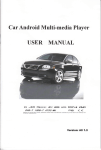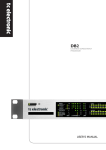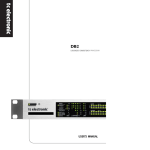Download Classic450 - TC Electronic
Transcript
Classic450 USER’S MANUAL 1 2 3 4 5 6 7 8 9 10 11 12 14 Read these instructions. Keep these instructions. Heed all warnings. Follow all instructions. Do not use this apparatus near water. Clean only with dry cloth. Do not block any ventilation openings. Install in accordance with the manufacturer’s instructions. Do not install near heat sources such as radiators, heat registers, stoves, or other apparatus (including amplifiers) that produce heat. Do not defeat the safety purpose of the polarized or grounding-type plug. A polarized plug has two blades with one wider than the other. A grounding type plug has two blades and a third grounding prong. The wide blade or the third prong are provided for your safety. If the provided plug does not fit into your outlet, consult an electrician for replacement of the obsolete outlet. Protect the power cord from being walked on or pinched, particularly at plugs, convenience receptacles, and the point where they exit from the apparatus. Only use attachments/accessories specified by the manufacturer. 12 Use only with the cart, stand, tripod, bracket, or table specified by the manufacturer or sold with the apparatus. When a cart is used, be careful when moving the cart/apparatus combination to avoid injury from tip-over. 13 Unplug this apparatus during lightning storms or when not in use for longer periods of time. Refer all servicing to qualified service personnel. Servicing is required when the apparatus has been damaged in any way, such as when a power supply cord or plug is damaged, liquid has been spilled or objects have fallen into the apparatus, or if the apparatus has been exposed to rain or moisture, does not operate normally or has been dropped. Warning! • To reduce the risk of fire or electrical shock, do not expose this equipment to dripping or splashing and ensure that no objects filled with liquids, such as vases, are placed on it. • This apparatus must be earthed. • Use a three wire grounding type line cord like the one supplied with the product. • Be advised that different operating voltages require the use of different types of line cord and attachment plugs. • Check the voltage in your area and use the correct type. Please refer to the following table: • • • • • Voltage Line plug according to standard 110-125V UL817 and CSA C22.2 no 42. 220-230V CEE 7 page VII, SR section 107-2-D1/IEC 83 page C4. 240V BS 1363 of 1984. Specification for 13A fused plugs and switched and unswitched socket outlets. This equipment should be installed near the socket outlet and disconnection of the device should be easily accessible. To completely disconnect from AC mains, disconnect the power supply cord from the AC receptacle. The mains plug of the power supply shall remain readily operable. Do not install in a confined space. Do not open the unit – risk of electric shock inside! Caution: You are cautioned that any change or modifications not expressively approved in this manual could void your authority to operate this equipment. Service • There are no user-serviceable parts inside. • All service must be performed by qualified personnel. a EN IMPORTANT SAFETY INSTRUCTIONS EMC / EMI & CERTIFICATE OF CONFORMITY EMC/EMI This equipment has been tested and found to comply with the limits for a Class B Digital device, pursuant to part 15 of the FCC rules. These limits are designed to provide reasonable protection against harmful interference in residential installations. This equipment generates, uses and can radiate radio frequency energy and, if not installed and used in accordance with the instructions, may cause harmful interference to radio communications. However, there is no guarantee that interference will not occur in a particular installation. If this equipment does cause harmful interference to radio or television reception, which can be determined by turning the equipment off and on, the user is encouraged to try to correct the interference by one or more of the following measures: • • • • Reorient or relocate the receiving antenna. Increase the separation between the equipment and receiver. Connect the equipment into an outlet on a circuit different from that to which the receiver is connected. Consult the dealer or an experienced radio/TV technician for help. For Customers in Canada: This Class B digital apparatus complies with Canadian ICES-003. Cet appareil numérique de la classe B est conforme à la norme NMB-003 du Canada. Certificate of Conformity TC Electronic A/S, Sindalsvej 34, 8240 Risskov, Denmark, hereby declares on own responsibility that the following product: Classic450 – Bass amplifier that is covered by this certificate and marked with CE-label conforms with following standards: EN 60065 Safety requirements for mains operated (IEC 60065) electronic and related apparatus for household and similar general use EN 55103-1 Product family standard for audio, video, audio-visual and entertainment lighting control apparatus for professional use. Part 1: Emission. EN 55103-2 Product family standard for audio, video, audio-visual and entertainment lighting control apparatus for professional use. Part 2: Immunity. With reference to regulations in following directives: 2006/95/EC, 89/336/EEC Issued in Risskov, June 2009 Anders Faurskov Chief Executive Officer b TABLE OF CONTENTS INTRODUCTION EN Important Safety Instructions & Certificate of Conformity . . . . . . . . . . . . . . . . . . .a-b Table of Contents . . . . . . . . . . . . . . . . . . . . . . . . . . . .3 Introduction . . . . . . . . . . . . . . . . . . . . . . . . . . . . . . . .4 Quick Setup Guide . . . . . . . . . . . . . . . . . . . . . . . . . . .5 OPERATION Front Panel . . . . . . . . . . . . . . . . . . . . . . . . . . . . . . . . .6 Rear Panel . . . . . . . . . . . . . . . . . . . . . . . . . . . . . . . . .9 APPENDIX General Protection mode . . . . . . . . . . . . . . . . . . . . .11 Heat Protection mode . . . . . . . . . . . . . . . . . . . . . . .11 Technical Specifications . . . . . . . . . . . . . . . . . . . . . .13 TC Electronic, Sindalsvej 34, DK-8240 Risskov – [email protected] English Version Manual Revision 1.0 – SW – V 1.0 3 INTRODUCTION TC Electronic Classic450 – pure tone meets sheer power… Introducing TC Electronic Classic450 – a brand new bass amp that’s all about pure tone and power. After showing the world our bass amp credentials with the award-winning RH450, we are back to bass basics with Classic450 – an amp that offers players easy access to a selection of classic tones based on several vintage combos, all via a versatile tone control section. This sound palette sits on the solid foundation of TC Electronic’s Tubetone™ and multiband SpectraComp™ technologies. TubeTone™ emulates every characteristic of a tube pre-amp and power-amp to deliver the full tube sound. SpectraComp™ allows virtually “per string” compression that evens out the compression across all strings, delivering a quality, punchy sound. Classic450’s input section caters for both active and passive pickups, while its output is transformer-balanced and galvanically isolated from the other components of the amp, effectively eliminating ground loops and hum. Classic450 is fully compatible with all TC Electronic RS cabinets and will drive any triple combination of the existing models (RS210, RS212, RS410). And with a fully transformer-balanced line driver output, you get a perfect reproduction of Classic450’s tone both for recording and live use – making the amp equally at home on the road and in the studio. Classic450 is what bass players have been missing: classic sounds, ease of use and raw power; all in a compact and sturdy box that can be taken anywhere. Please note: We reserve the rights to change the contents of this manual at any time. The latest manual revision can always be downloaded from www.tcelectronic.com. If you need additional information or support, be sure to visit TC Support Interactive, which you can also access via www.tcelectronic.com. Finally, you may enjoy and learn from the tutorial videos by TC Electronic. You can access these videos from our site or via TC Electronic’s Youtube channel at http://www.youtube.com/tcelectronic 4 QUICK SETUP GUIDE Unpacking • Unpack your Classic450 amp. • The box should contain the following items: – Classic450 amplifier – Power Cable – Manual • Inspect all items for signs of transit damage. In the unlikely event of any damage, inform the carrier and supplier. • In case of damage, keep all the packaging, as this will show evidence of excessive handling force. • It is also a good idea to keep the packaging for future transportation. Setting up • Connect the Speaker Out jack of the amplifier to your cabinet using a Speakon speaker cable. • You can connect up to three RS cabinets or any other two 8 Ohm cabinets of another brand to the amplifier. The minimum load is 4 Ohm. • • • • • Connect the power cable and power up. The Classic450’s power supply accepts voltages from 100 to 240 VAC. Connect your bass to the input jack on the front panel. Adjust the input gain using the GAIN knob. Adjust the output volume using the MASTER knob. Play! EN If you just can’t wait… Here are a few quick steps to get you playing within minutes. Accessories The following items can be purchased from your music dealer: • RS cabinets 210/212/410 • 19" bracket (allowing you to mount the amplifier in a standard 19" rack) • Classic450 soft bag • Classic450 flight case • Flight cases for RS cabinets. Be sure to check www.tcelectronic.com for latest news about these and other TC products. 5 OPERATION – FRONT PANEL Front Panel 1 – INPUT You can connect an active or passive bass to this ¼" input jack. The Classic450 input stage is designed to adapt to any type of pickup. 2+3 – GAIN & PEAK LED The input gain should be set to the highest possible level without overloading the input stage. To find the correct setting, simply plug in your bass, play and turn up the GAIN knob until the PEAK LED occasionally lights up. Then reduce the gain slightly. When set, simply turn up the MASTER volume knob to the desired level and start playing. 6 4 – SPECTRACOMP™ Turn this knob to set the desired amount of SpectraComp compression. SpectraComp™ uses a so-called spectral or multi-band approach to compression, allowing for individual compression of the low, mid and high frequency bands. Multi-band compression allows a significantly smoother and more transparent compression without killing dynamics or tone. SpectraComp™ is an advanced compressor, optimized to get the best from a bass signal. Turn the knob and try it out! “0” means “no compression”, while “10” gives you maximum compression. If you want to learn a bit more about what is going on behind the scenes, please read the section “SpectraComp In Depth” below. SpectraComp in Depth Compression Meter When using SpectraComp™, the compression meter indicates the amount of compression applied to the signal (see “9 – Compression meter“). Auto Make-up Gain By nature, compression reduces the loudest parts and peaks of the signal, so you may feel that many conventional compressors “eat” the level of your signal, resulting in a lower output volume. SpectraComp™ automatically compensates for this type of gain reduction, giving you an even output volume. Spectral Compression vs. Full Band Compression Virtually any compressor on the market for electric bass guitars is based on a “full band” principle – meaning that the compressor will respond and compress the signal identically across the full (20 Hz to 20 kHz) frequency range. However, the electric bass has a very wide dynamic range, from the low E (or B) to the G string. When using standard compressors, the low E string will – due to its higher energy – control when and how the compressor responds to (and shapes) the entire signal. Typically, the result is that either the G string is not compressed at all or that – just when the G string starts to sound right –, the low E string is compressed too strongly. In other words: You are constantly dealing with a tight and difficult compromise. With Spectral Compression, the Classic450 amplifier uses a different approach that allows for independent compression of the Low, Mid and High frequency areas. This way, the right amount of compression is added to the individual strings of your bass, resulting in a smoother and much more transparent compression. 5 – TONE Controls The Classic450 has four tone controls: Bass, Lo-mid, Hi-mid and Treble. The calibration and tuning of these tone controls was inspired by classic vintage amplifiers, and they address four relevant bass frequency areas, allowing you to dial in your preferred classic tone with ease. Gain ranges and Frequencies: Bass Freq: 200 Hz Bass Gain range: -24 dB to +15 dB (Shelving type) Low Mid Freq: Low Mid Gain range: 400 Hz -24 dB to +15 dB High Mid Freq: High Mid Gain range: 800 Hz -24 dB to +15 dB Treble Freq: Treble Gain range: (Shelving type) 1600 Hz -24 dB to +12 dB 7 EN OPERATION – FRONT PANEL OPERATION – FRONT PANEL 6 – TUBETONE™ Tubetone™ allows you to alter the “personality” and sound of your Classic450. The effects you can achieve range from a small touch of classic tube amp response and character through obvious but pleasant “tube attitude” to highly overdriven. Contrary to many tube simulations, Tubetone™ recreates both the entire preamp section (located before the tone control section) and the power amp section (located after the tone controls). Not only does this give you the most realistic and flexible recreation of the actual tube sound and response, but it also allows you to alter the behavior and character of Tubetone™ through the Classic450 tone controls as you would on an actual tube amp. 7 – MASTER Use the MASTER level knob to set the overall output level of the amp. Please note that you should set the input level using the GAIN knob, as described in section “2+3 – GAIN & PEAK LED”. 8 – MUTE The MUTE button mutes both the speaker output and the balanced output. This means that you can tune your instrument with no sound going to your own rig or to the PA. 9 – Compression Meter This meter indicates the amount of applied compression. The more LEDs are lit, the more compression is applied. The amount of compression applied is determined by the setting of the SPECTRACOMP knob and the level of the input signal. Notice that the output levels of different bass pick-up systems vary considerably, and you may need to change the SpectraComp settings when switching to another bass. 10 – ON LED When this LED is lit (green), power is on. The TUBETONE knob adjusts the amount of both the preamp and the power-amp tube simulation. 8 OPERATION – REAR PANEL EN Rear Panel 1 – MAINS IN – Power In & POWER Switch The Classic450’s auto-sensing switch-mode power-supply accepts any mains voltage from 90 to 240 volts – you do not have to change settings, fuses or anything else. Simply connect a standard IEC three pin connector to the local mains voltage, and you are up and running. This is particularly handy when you use the Classic450 on a tour. The Classic450 can be used to drive any cabinet combination of up to three RS 210/212/410 cabinets or up to two 8 Ohm cabinets of another brand. RS cabinets have Speakon inputs. The ground pin of the power-supply unit (PSU) must be connected in order to avoid voltage differences between e.g. the PA and the Classic450. 2 – SPEAKER OUT Use the SPEAKER OUT combo connector for connecting the Classic450 to your cabinet(s). You can use a speaker cable with either Speakon or ¼" jacks. Do NOT use instrument cables! 9 OPERATION – REAR PANEL 3 + 4 – SEND TUNER OUT + RETURN These jacks provide a break point between the Classic450’s preamp section (which includes SpectraComp™, Tone controls and the TubeTone™ module) and the power amp section. This break point can be used as a regular serial effects loop for inserting e.g. modulation effects or for other external devices, such as a tuner. When you connect a tuner to the SEND TUNER OUT jack, this tuner will receive a signal even when you have muted the speaker and line driver outputs by pressing the MUTE button on the front panel. Linking Two Amps The SEND TUNER OUT and RETURN effects loop jacks may also be used to link two Classic450 units together to achieve even more power. – Use a standard ¼" jack instrument cable to connect the first Classic450’s SEND TUNER OUT jack (the upper of the two jacks) to the second Classic450’s RETURN jack. – Plug your bass into the INPUT jack on the first Classic450 and adjust your sound using the controls on this Classic450. – Set the volume using the MASTER volume knobs of both amps. You now have tons of amplification power at your fingertips! 5 – PRE/POST switch The PRE/POST switch determines the position of the tap-point for the LINE DRIVER OUT. In “pre” position the signal is tapped right after the input gain control. In “post” position the signal is tapped after the Spectracomp, tonecontrols and Tubetone section. 6 – LINE DRIVER OUT – Balanced Line Out Use the LINE DRIVER OUT jack to connect the Classic450 to your band’s PA when you play on stage or to connect your amp to a recording device when you are in the studio. To determine where in the signal chain the signal for the balanced output should be tapped, use the PRE/POST switch located right beside the LINE DRIVER OUT jack. The Classic450’s MUTE button mutes the balanced output as well as the speaker outputs. This means that you can tune up with no sound going to your own rig or to the PA. The Classic450’s balanced output has been designed with the utmost care for great sound. This is achieved through galvanically isolated transformer coupling. The active design outperforms most standard DI boxes by far, and it is capable of driving long cable hauls. No phantom power is required. Ventilation Be sure not to cover the black cooling plate of the Classic450! Insufficient ventilation may cause the amplifier’s temperature to increase. 10 Introduction The Classic450 is equipped with an intelligent protection system, ensuring that the amp does not suffer or malfunction if operated wrongly or in extreme environments. Heat Protection Mode If the Peak LED lights up while the amp is in General Protection mode, the amp is too hot. This is rarely seen, but a few extreme situations can invoke this mode: General Protection Mode The compression meter has five LEDs. If the two left LEDs and the two right LEDs start blinking alternatingly, the amplifier is in Protection mode. a) If the amplifier is used in an environment that is too hot, or if proper ventilation is not ensured. Protection mode is invoked when, for some reason, a shortcircuit situation occurs. In Protection mode, the speaker outputs are shut off so that the speakers cannot be damaged by a shortcut. However, even in General Protection mode, the balanced output and the effect loops out (SEND TUNER OUT) are still passing audio. To solve the problem, try turning off the Classic450 for a minute and then turn it on again. If protection mode is still indicated, you will have to send the Classic450 to a qualified service-center for inspection. b) Cabinets or combinations of cabinets must load the amplifier with a minimum of 4 Ohm. You can use a maximum of three RS cabinets or two 8 Ohm cabinets of any other brand. If e.g. the speaker output is loaded with only 2 Ohm or less and you drive the Classic450 at very high volumes over a long period of time, the amplifier enters Heat Protection mode. In – – – – both situations, proceed as follows: Turn off the amplifier. Solve the issues. Allow the amplifier to cool off for a few minutes. Turn the amplifier on again. 11 EN APPENDIX – MISCELLANEOUS APPENDIX – SIGNAL FLOW 12 Input Section Input connector Input impedance Gain range Tone controls Bass Low Mid High Mid Treble ¼" jack 1 MOhm / 100 pF -96 to 32 dB Freq: 200 Hz (Gain: +15/-24 dB) - Shelving type 3 dB slope Center Freq: 400 Hz (Gain: +15/-24 dB) Center Freq: 800 Hz (Gain: +15/-24 dB) Default Freq: 1600 Hz (Gain: +12/-24 dB) - Shelving type 3 dB slope Tube Tone 0 to 10, Tube amp Recreation Spectra Comp 3 band Spectral Compression Mains supply Universal 100 to 240V 50/60 Hz (80 w @ 1/8 Power) Speaker out Combined Speakon / ¼" jack Power rating 450 W (800 W Peak) @ 4 Ohm Balanced output Max. Output Minimum Load Transformer Balanced XLR, Pre/Post Pre-amp +0 dBu 4 Ohm Master Level 0 to 10, Speaker Output Level Tuner out (Preamp out) ¼" Jack, Balanced Output, Max. Output Level = +8 dBu Power amp in ¼" Jack, balanced input, impedance = 10 kOhm, Max Input Level = +8 dBu Dimensions 275 x 290 x 66 mm / 10,8” x 11,4” x 2,6” Weight 4 kg / 8.8 pounds Finish Sandblasted die-cast aluminum EN APPENDIX – TECHNICAL SPECIFICATIONS Due to continuous development, these specifications are subject to change without notice. 13





























